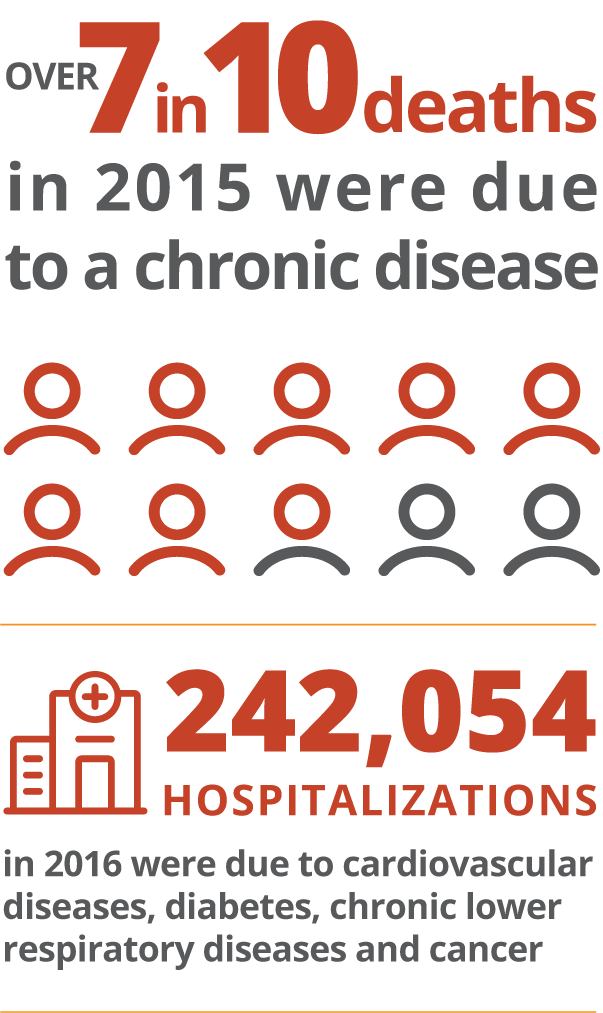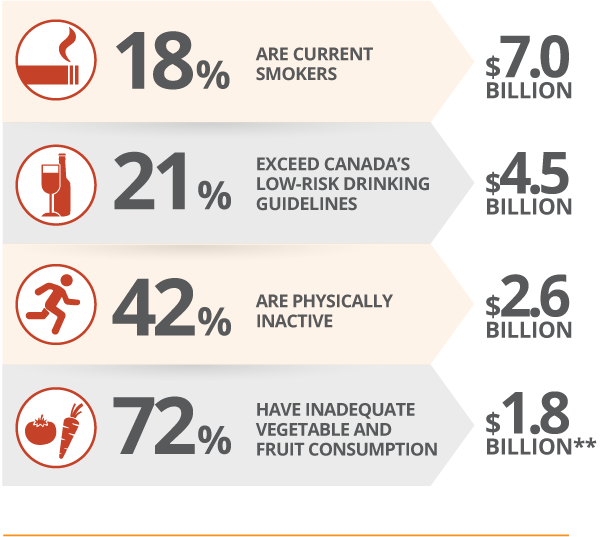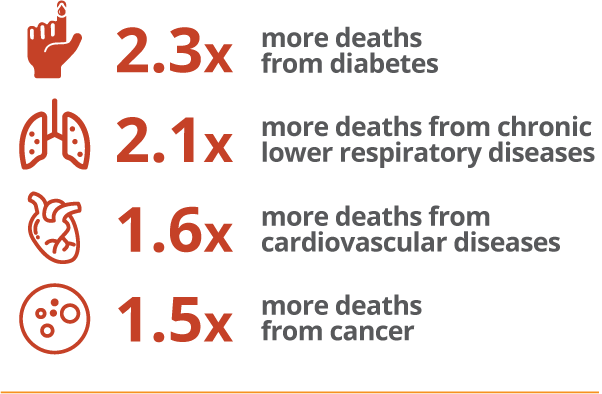Chronic Disease Prevention Strategy 2020–2023
This is our second strategy for chronic disease prevention, and the first to incorporate all areas of work at Ontario Health. It builds on the accomplishments of the first strategy, which spanned 2015 to 2020.
The Chronic Disease Prevention Strategy 2020 to 2023 was developed in collaboration with our partners. It considers both provincial and regional initiatives, and harnesses our collective expertise to guide our work to prevent chronic disease and improve population health.
Improving population health is a core component of the quadruple aim framework, which depicts our approach to improving healthcare.[*]

To advance chronic disease prevention, we will need to tackle the difficult situations facing our prevention and health care systems, such as ongoing systemic inequities and the challenges posed by COVID-19. This strategy outlines concrete strategic objectives and actions to support these efforts.
This strategy reflects our formative stages and captures the ongoing initiatives being led across the organization. The work done over the next 3 years will set the stage for Ontario Health to realize further progress in chronic disease prevention, and ensure the best outcomes for the people of Ontario.
GOALS, STRATEGIC OBJECTIVES AND ACTIONS
Goal 1:
Work with partners to champion chronic disease prevention in Ontario
Ontario Health partners with many organizations for our work in chronic disease prevention. We are especially fortunate to have strong relationships with several First Nations, Inuit, Métis and urban Indigenous partners. We will continue to collaborate with our partners to make meaningful advances in chronic disease prevention in Ontario.
Objectives and actions by 2023
Work with Ontario’s chronic disease prevention partners to align and address common priorities
- Engage Ontario’s leaders in chronic disease prevention through advisory committees, partnership tables, non-governmental organizations and health networks to implement the Chronic Disease Prevention Strategy 2020 to 2023.
- Share information and collaborate on joint projects and common priorities with chronic disease prevention partners.
- Develop new and strengthen existing partnerships.
Engage multiple sectors and levels of government to integrate health considerations in public policy development
- Engage with ministries across the government.
- Collaborate with public health groups, including Public Health Ontario, local boards of health and professional public health associations.
- Submit consultations, reports and other guidance to governments and policy-makers.
- Lead health initiatives for workers through the Occupational Cancer Research Centre in collaboration with occupational health and safety partners.
Work with and support partners to address chronic disease risk in First Nations, Inuit, Métis and urban Indigenous people
- Implement actions to address chronic disease as part of the strategic priority on prevention in the First Nations, Inuit, Métis and Urban Indigenous Cancer Strategy 2019 to 2023.
For more information
First Nations, Inuit, Métis and Urban Indigenous Cancer Strategy 2019 to 2023
The fourth strategy to improve cancer care for Indigenous people in Ontario continues the work set out in the first three strategies.
Read the First Nations, Inuit, Métis and Urban Indigenous Cancer Strategy
Goal 2:
Promote chronic disease prevention policies and programs
System-level policies and programs can significantly reduce the risk of chronic disease. Therefore, we will promote policies and programs that aim to reduce the risk of chronic disease.
Objectives and actions by 2023
Provide evidence-based advice to governments on policies and programs for preventing chronic disease
- Develop evidence syntheses and recommendations on existing and emerging topics in chronic disease prevention.
Promote policies and programs that increase health equity
- Promote using tools and resources that support health equity education and assessment, such as the Indigenous Relationship and Cultural Safety courses.
- Build Ontario Health’s capacity to assess and address health equity in our workplace and in the work we do.
Monitor policies and programs related to chronic disease prevention
- Publish Prevention System Quality Index (PSQI) reports to monitor and inform Ontario’s efforts in prevention, including a report on effective policies and programs related to mental health and addictions.
- Monitor the prevalence of chronic disease risk factors, including socio-demographic risk factors, and cancer screening program performance.
Promote healthy environments in public workplaces
- Develop a framework for increasing access to healthy food in retail outlets (e.g., food kiosks and cafeterias) at hospitals.
- Support a healthy workplace at Ontario Health.
For more information
Indigenous Relationship and Cultural Safety courses
These 13 courses are designed to help anyone working with First Nations, Inuit and Métis people to provide culturally appropriate, person-centred care.
Find out more about Indigenous Relationship and Cultural Safety courses
Prevention System Quality Index (PSQI)
Learn about Ontario’s programs and policies related to risk factors for cancer and other chronic diseases.
Goal 3:
Undertake primary, secondary and tertiary prevention
Primary prevention aims to prevent chronic disease by reducing exposure to risk factors. Secondary prevention aims to improve health outcomes by finding diseases early through screening. Screening is testing done on people who have no symptoms and generally feel fine. It can find conditions early when treatment has a better chance of working. Tertiary prevention aims to lessen the effects of a disease, slow its progression and reduce the risk of recurrence.
We will maintain our existing programs across the prevention continuum throughout COVID-19, and where possible, continue to grow and strengthen these programs.
Objectives and actions by 2023
Broaden the reach of Ontario Health’s prevention programs
- Continue to expand prevention programs to reach new populations.
Strengthen Ontario’s screening and early detection programs
- Resume operations of our screening and early detection programs beyond COVID-19.
- Strengthen the organized cancer screening programs in alignment with evolving evidence-based recommendations.
- Implement human papillomavirus (HPV) testing as the recommended screening method in the Ontario Cervical Screening Program.
- Continue to implement the glomerulonephritis model of care across Regional Renal Programs.
Undertake initiatives in prevention and screening to reduce health inequities
- Support chronic kidney disease risk screening in First Nations communities.
- Plan and carry out initiatives to address inequities in cancer screening program participation.
Inform people in Ontario about how to reduce their risk of chronic disease
- Promote the use of digital and other tools, such as My CancerIQ, by the public.
- Continue to inform and provide educational tools to First Nations, Inuit, Métis and urban Indigenous communities to support commercial tobacco cessation, protection and prevention.
- Undertake awareness campaigns and publish evidence-based knowledge products that provide the public with information on reducing their risk of developing chronic diseases.
Support primary care providers in delivering prevention and screening to their patients
- Equip primary care providers with data and tools, including digital tools, to help facilitate prevention and screening.
- Integrate prevention and screening guidance into clinical advice documents.
For more information
Smoking cessation programs
These programs screen people who are newly diagnosed with cancer for tobacco use, advise them on the benefits of quitting smoking and refer them to cessation services for support.
Find out more at Smoking Cessation Information for Health care Providers
My CancerIQ
This online tool allows people in Ontario to complete risk assessment questionnaires for several cancers. It also provides information on cancer prevention and screening, and credible behaviour change resources.
Policy for screening trans people in the breast and cervical screening programs
This policy outlines the recommendations for addressing the barriers that trans and non-binary people may experience when accessing organized cancer screening services.
Read the Overarching Policy for the Screening of Trans People
Goal 4:
Inform chronic disease prevention through research, and population health assessment and surveillance
Through high-quality evidence synthesis, generation and dissemination, we will provide information needed for people to understand and take action on chronic disease prevention.
Objectives and actions by 2023
Improve the evidence base and understanding of chronic disease prevention
- Conduct and support research on chronic disease causes, prevention and screening.
Strengthen Ontario Health’s data holdings and data infrastructure
- Identify and address information gaps, and use the data holdings and infrastructure to support research, planning and surveillance.
Provide risk factor, screening and disease surveillance information that informs chronic disease prevention
- Publish reports and knowledge products, such as fact sheets, on risk factors, including socio-demographic risk factors, and screening.
- Publish reports and knowledge products on disease surveillance information, such as Ontario Cancer Statistics.
Provide data and evidence-based guidelines that support ongoing quality improvement in prevention and screening
- Support quality improvement through quality standards, evaluation and reporting.
For more information
Occupational Disease Surveillance System
This system links existing provincial health databases with job information to study occupational disease and inform prevention activities, including examining disease trends over time.
Find out more about the Occupational Disease Surveillance System
ONTARIO CANCER STATISTICS
This report provides comprehensive information on the changing burden of cancer in Ontario using more than 30 years of data from the Ontario Cancer Registry.
CHRONIC DISEASE IN ONTARIO
For Ontario to have a sustainable health care system, we must minimize exposures to common chronic disease risk factors and the risk of developing chronic diseases.
Chronic disease prevention plays a critical role in ensuring we can address the population health component of the quadruple aim framework.
Chronic diseases are the leading cause of death in Ontario. They are costly to treat and largely preventable.[*]

Chronic disease risk factors are common in Ontario adults, and related health care and indirect costs are substantial.[*]

Some populations in Ontario have a disproportionate burden of chronic diseases. People with low income are more likely to die from chronic disease compared to people with high income.[*]

EVALUATING OUR PROGRESS
As an integrated health agency, Ontario Health has tremendous potential to advance chronic disease prevention.
Over the coming years, we will measure and monitor our progress towards implementing initiatives outlined in this strategy. We will do this by tracking key indicators for managing performance and measuring progress. Our evaluation approach will be iterative and accommodate changes that may develop over the span of the strategy.
Our achievements so far
The first chronic disease prevention strategy was developed under Cancer Care Ontario before it transitioned to Ontario Health. The Progress in Prevention: Achievements from the Chronic Disease Prevention Strategy 2015 to 2020 report highlights the achievements in chronic disease prevention under this first strategy from April 1, 2015, to March 31, 2020.
Some of these achievements include:
- Transitioning from the guaiac fecal occult blood test (gFOBT) to the fecal immunochemical test (FIT) as the screening test for people at average risk of developing colorectal cancer. We expect this transition to lead to an increase in colorectal cancer screening participation.
- Integrating smoking cessation programs into regional cancer centres. As a result, more people with cancer are screened for tobacco use and offered help to quit smoking.
- Leading the development of the Occupational Disease Surveillance System. This system links provincial health databases with job information to support studies of occupational disease and inform prevention activities.
For more information
Progress in Chronic Disease Prevention: 2015 to 2020
Learn about our work towards achieving the goals in the Chronic Disease Prevention Strategy 2015 to 2020.
ABOUT THIS STRATEGY
This strategy was developed in consultation with several of our chronic disease prevention partners. These include the Ontario Health (Cancer Care Ontario) Prevention Advisory Committee, patient and family advisors, government agencies, not-for-profit health organizations, researchers and public health experts.
This strategy builds on our achievements to date, highlights new opportunities to strengthen our efforts in chronic disease prevention, and captures the work in chronic disease prevention across Ontario Health.
It harnesses our expertise and that of our partners to serve as a comprehensive guide for preventing chronic disease in the province and improving population health.
To explore opportunities to collaborate on chronic disease prevention, send us an email.
Acknowledgements
Many individuals and organizations across the province contributed to the development of this strategy. In particular, we would like to acknowledge the contributions of the Ontario Health Chronic Disease Prevention Strategy Working Group. We are grateful for their insights and expertise, and thank them for their efforts in advancing chronic disease prevention in Ontario.









